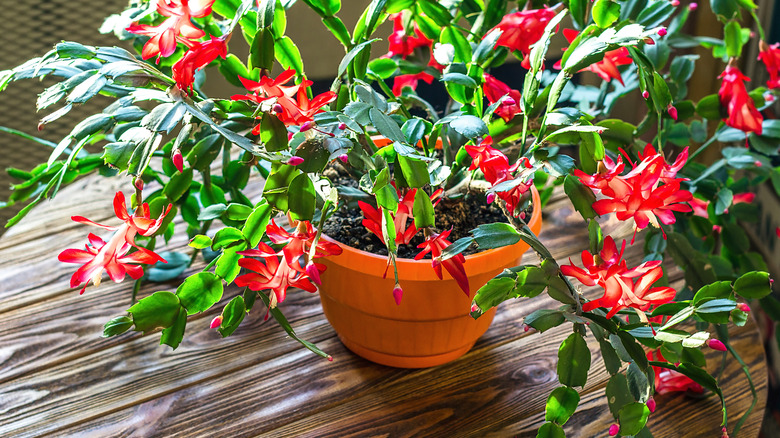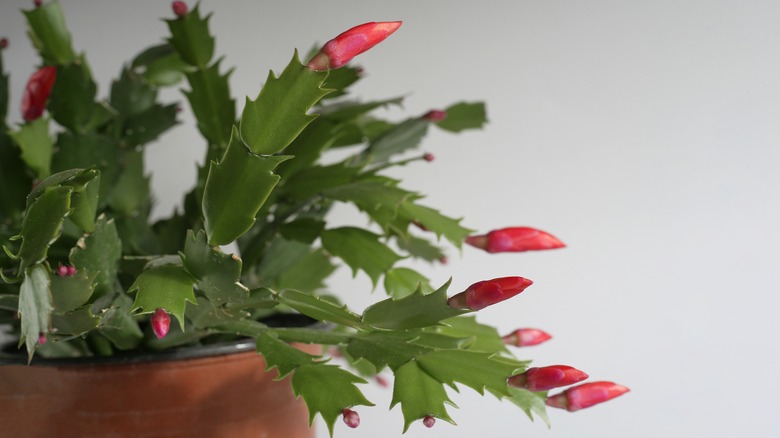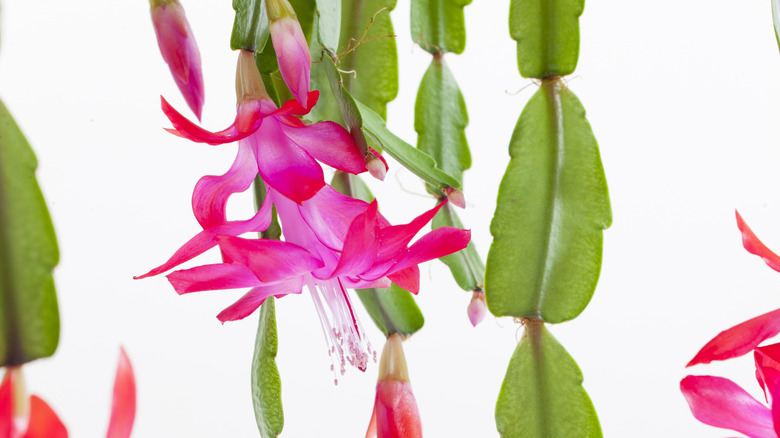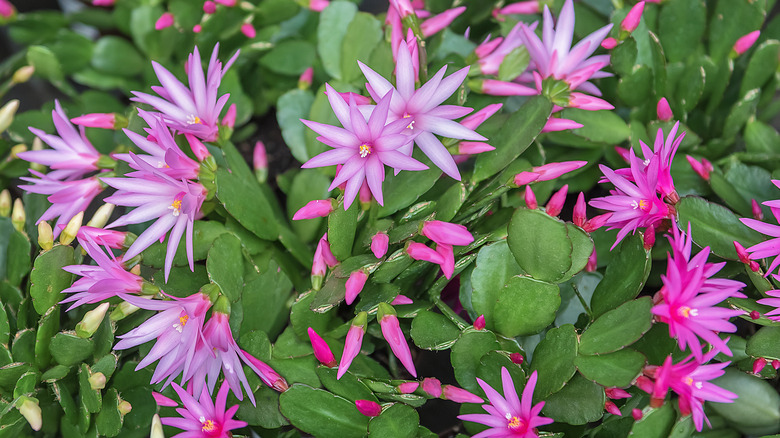What's The Difference Between A Thanksgiving Cactus And A Christmas Cactus?
When it comes to holiday cacti, there is much confusion over which species is which and when, in fact, you can expect yours to bloom. It's logical to think a Thanksgiving cactus (Schlumbergera truncata) will produce flowers in November followed by a Christmas cactus (Schlumbergera x buckleyi) blossoming at the end of the year; however, it's not that easy to tell these very similar plants apart.
Thanksgiving and Christmas cacti certainly have more in common than not, and the primary reason for this is that most of those sold in stores today are hybrid varieties of the originals. Two distinct types of epiphytes (Schlumbergera truncata and Schlumbergera russellianum) were discovered in the early to mid 1800s in Brazil, explains the University of Georgia Extension. The first tends to bloom in the fall, while the latter blooms in early spring, and the resulting hybrid is the plant that blossoms at Christmastime. It gets confusing because there are now over 200 hybrid varieties available with varying bloom times and flower colors, per NC State Extension Gardener, so neither of those identifiers is the key to truly knowing exactly what you've got sitting on your counter.
Similarities aside, Schlumbergera truncata and Schlumbergera x buckleyi are different species of plants. The easiest and truest way to tell which kind of cactus you've been tending to all these years comes from taking a very close look at the characteristics of its stem segments, which are sometimes mistaken to be leaves.
Spiky toothed edges on the stem segments
Teeth on a cactus, really? Actually, what we're referring to here are the jagged tooth-like edges of the stem segments of a true Thanksgiving cactus, the Schlumbergera truncata variety. These connected segments branch out from the center of the plant and are often thought to be leaves, but botanically speaking, they're considered long flattened green stems called cladophylls, notes NC State Extension Gardener. The spiky edges of each segment give the plant the nickname crab claw. Even though they look rough and sharp, they're actually rather soft to the touch.
Thanksgiving cactus flowers are erect and perky, arriving in showy fashion in white or varying shades of red, pink, purple, or yellow. They usually bloom on time in November and into December, but just to keep things in the world of holiday cacti interesting, a Thanksgiving cactus will occasionally shoot out another round of flowers in February. You can find this plant labeled as everything from a crab cactus to a Christmas cactus to a false Christmas cactus, but once you spot those teeth you'll know the truth of what it really is.
Smooth edges on the stem segments
From a distance, it's easy to mistake a Christmas cactus for the Thanksgiving variety because the long stems branch out in the same segmented patterns and produce flowers at the ends of each one. Instead of those jagged teeth along the stem segments, though, look closely for smooth edges; these indicate that you do indeed have a true Christmas cactus. NC State Extension Gardener describes the edges as scalloped and further notes that the flowers, typically present from November until the middle of February, bloom throughout winter in pink and light purple. Here's another small difference: Instead of displaying erect, the blossoms droop down from the ends of the stems.
This species of plant has undergone a few botanical name changes over the years. The most up-to-date proper Latin name for it is Schlumbergera x buckleyi, which was chosen to commemorate the horticulturist William Buckley who cultivated the hybrid about 10 years after the original S. truncate and russelliana species were discovered in Brazil, according to Missouri Botanical Garden. You may still see it incorrectly labeled as S. bridgesii. Dave's Garden explains that this is due to a publishing error that has persisted through the years even though it was scientifically corrected back in the 1960s.
Don't forget about Easter
Of course, there's a third holiday cactus of which we at least need to make mention. Called the Easter cactus because its perky pink or red blossoms arrive in the spring, Schlumbergera gaertneri (previously known as Hatiora gaertneri) is a long day cactus. This refers to the fact that its flowers emerge after winter passes and the days become longer, according to the University of Arizona Cooperative Extension.
NC State Extension Gardener says the Easter Schlumbergera is the toughest of the three to grow and also the hardest to find. Again, compare the stem segments to confirm you've definitely gotten your hands on one. A true Easter cactus will lack the spiky teeth of the Thanksgiving variety. It will have the smoother, scalloped edges of the Christmas variety, however, each segment scallop will be even rounder.
Per the University of Arizona, a root-bound Easter cactus is a happy Easter cactus. Make sure its potting mix drains completely and is heavy on the perlite or other substrates for container garden aeration. Dropped stem segments are a sure sign of improper watering, but it will be up to the gardener to figure out if that means too much or too little.



